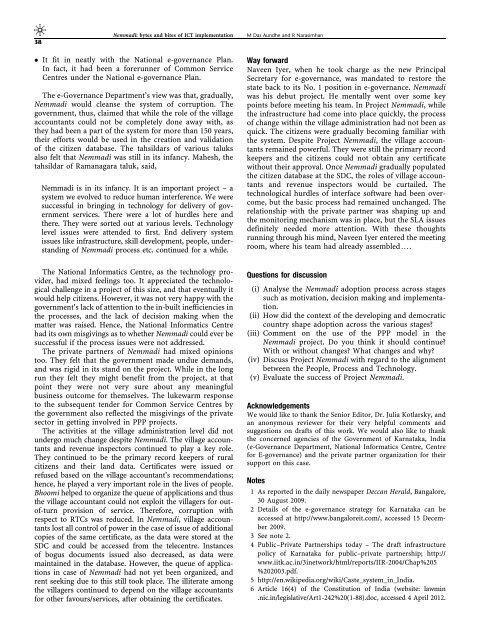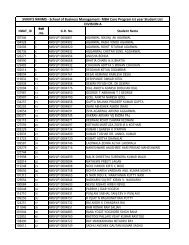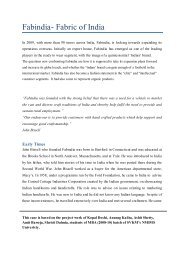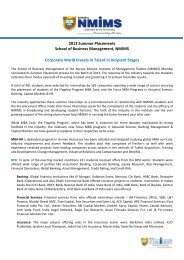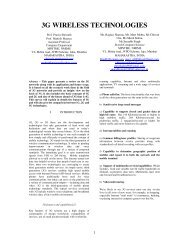Dr.-Ramesh-Narasimhan-Case-study-on-ICT-Adoption - NMIMS
Dr.-Ramesh-Narasimhan-Case-study-on-ICT-Adoption - NMIMS
Dr.-Ramesh-Narasimhan-Case-study-on-ICT-Adoption - NMIMS
Create successful ePaper yourself
Turn your PDF publications into a flip-book with our unique Google optimized e-Paper software.
38<br />
Nemmadi: bytes and bites of <strong>ICT</strong> implementati<strong>on</strong> M Das Aundhe and R <str<strong>on</strong>g>Narasimhan</str<strong>on</strong>g><br />
It fit in neatly with the Nati<strong>on</strong>al e-governance Plan.<br />
In fact, it had been a forerunner of Comm<strong>on</strong> Service<br />
Centres under the Nati<strong>on</strong>al e-governance Plan.<br />
The e-Governance Department’s view was that, gradually,<br />
Nemmadi would cleanse the system of corrupti<strong>on</strong>. The<br />
government, thus, claimed that while the role of the village<br />
accountants could not be completely d<strong>on</strong>e away with, as<br />
they had been a part of the system for more than 150 years,<br />
their efforts would be used in the creati<strong>on</strong> and validati<strong>on</strong><br />
of the citizen database. The tahsildars of various taluks<br />
also felt that Nemmadi was still in its infancy. Mahesh, the<br />
tahsildar of Ramanagara taluk, said,<br />
Nemmadi is in its infancy. It is an important project – a<br />
system we evolved to reduce human interference. We were<br />
successful in bringing in technology for delivery of government<br />
services. There were a lot of hurdles here and<br />
there. They were sorted out at various levels. Technology<br />
level issues were attended to first. End delivery system<br />
issues like infrastructure, skill development, people, understanding<br />
of Nemmadi process etc. c<strong>on</strong>tinued for a while.<br />
The Nati<strong>on</strong>al Informatics Centre, as the technology provider,<br />
had mixed feelings too. It appreciated the technological<br />
challenge in a project of this size, and that eventually it<br />
would help citizens. However, it was not very happy with the<br />
government’s lack of attenti<strong>on</strong> to the in-built inefficiencies in<br />
the processes, and the lack of decisi<strong>on</strong> making when the<br />
matter was raised. Hence, the Nati<strong>on</strong>al Informatics Centre<br />
had its own misgivings as to whether Nemmadi could ever be<br />
successful if the process issues were not addressed.<br />
The private partners of Nemmadi had mixed opini<strong>on</strong>s<br />
too. They felt that the government made undue demands,<br />
and was rigid in its stand <strong>on</strong> the project. While in the l<strong>on</strong>g<br />
run they felt they might benefit from the project, at that<br />
point they were not very sure about any meaningful<br />
business outcome for themselves. The lukewarm resp<strong>on</strong>se<br />
to the subsequent tender for Comm<strong>on</strong> Service Centres by<br />
the government also reflected the misgivings of the private<br />
sector in getting involved in PPP projects.<br />
The activities at the village administrati<strong>on</strong> level did not<br />
undergo much change despite Nemmadi. The village accountants<br />
and revenue inspectors c<strong>on</strong>tinued to play a key role.<br />
They c<strong>on</strong>tinued to be the primary record keepers of rural<br />
citizens and their land data. Certificates were issued or<br />
refused based <strong>on</strong> the village accountant’s recommendati<strong>on</strong>s;<br />
hence, he played a very important role in the lives of people.<br />
Bhoomi helped to organize the queue of applicati<strong>on</strong>s and thus<br />
the village accountant could not exploit the villagers for outof-turn<br />
provisi<strong>on</strong> of service. Therefore, corrupti<strong>on</strong> with<br />
respect to RTCs was reduced. In Nemmadi, village accountants<br />
lost all c<strong>on</strong>trol of power in the case of issue of additi<strong>on</strong>al<br />
copies of the same certificate, as the data were stored at the<br />
SDC and could be accessed from the telecentre. Instances<br />
of bogus documents issued also decreased, as data were<br />
maintained in the database. However, the queue of applicati<strong>on</strong>s<br />
in case of Nemmadi had not yet been organized, and<br />
rent seeking due to this still took place. The illiterate am<strong>on</strong>g<br />
the villagers c<strong>on</strong>tinued to depend <strong>on</strong> the village accountants<br />
for other favours/services, after obtaining the certificates.<br />
Way forward<br />
Naveen Iyer, when he took charge as the new Principal<br />
Secretary for e-governance, was mandated to restore the<br />
state back to its No. 1 positi<strong>on</strong> in e-governance. Nemmadi<br />
was his debut project. He mentally went over some key<br />
points before meeting his team. In Project Nemmadi, while<br />
the infrastructure had come into place quickly, the process<br />
of change within the village administrati<strong>on</strong> had not been as<br />
quick. The citizens were gradually becoming familiar with<br />
the system. Despite Project Nemmadi, the village accountants<br />
remained powerful. They were still the primary record<br />
keepers and the citizens could not obtain any certificate<br />
without their approval. Once Nemmadi gradually populated<br />
the citizen database at the SDC, the roles of village accountants<br />
and revenue inspectors would be curtailed. The<br />
technological hurdles of interface software had been overcome,<br />
but the basic process had remained unchanged. The<br />
relati<strong>on</strong>ship with the private partner was shaping up and<br />
the m<strong>on</strong>itoring mechanism was in place, but the SLA issues<br />
definitely needed more attenti<strong>on</strong>. With these thoughts<br />
running through his mind, Naveen Iyer entered the meeting<br />
room, where his team had already assembledy.<br />
Questi<strong>on</strong>s for discussi<strong>on</strong><br />
(i) Analyse the Nemmadi adopti<strong>on</strong> process across stages<br />
such as motivati<strong>on</strong>, decisi<strong>on</strong> making and implementati<strong>on</strong>.<br />
(ii) How did the c<strong>on</strong>text of the developing and democratic<br />
country shape adopti<strong>on</strong> across the various stages?<br />
(iii) Comment <strong>on</strong> the use of the PPP model in the<br />
Nemmadi project. Do you think it should c<strong>on</strong>tinue?<br />
With or without changes? What changes and why?<br />
(iv) Discuss Project Nemmadi with regard to the alignment<br />
between the People, Process and Technology.<br />
(v) Evaluate the success of Project Nemmadi.<br />
Acknowledgements<br />
We would like to thank the Senior Editor, <str<strong>on</strong>g>Dr</str<strong>on</strong>g>. Julia Kotlarsky, and<br />
an an<strong>on</strong>ymous reviewer for their very helpful comments and<br />
suggesti<strong>on</strong>s <strong>on</strong> drafts of this work. We would also like to thank<br />
the c<strong>on</strong>cerned agencies of the Government of Karnataka, India<br />
(e-Governance Department, Nati<strong>on</strong>al Informatics Centre, Centre<br />
for E-governance) and the private partner organizati<strong>on</strong> for their<br />
support <strong>on</strong> this case.<br />
Notes<br />
1 As reported in the daily newspaper Deccan Herald, Bangalore,<br />
30 August 2009.<br />
2 Details of the e-governance strategy for Karnataka can be<br />
accessed at http://www.bangaloreit.com/, accessed 15 December<br />
2009.<br />
3 See note 2.<br />
4 Public–Private Partnerships today – The draft infrastructure<br />
policy of Karnataka for public–private partnership; http://<br />
www.iitk.ac.in/3inetwork/html/reports/IIR-2004/Chap%205<br />
%202003.pdf.<br />
5 http://en.wikipedia.org/wiki/Caste_system_in_India.<br />
6 Article 16(4) of the C<strong>on</strong>stituti<strong>on</strong> of India (website: lawmin<br />
.nic.in/legislative/Art1-242%20(1-88).doc, accessed 4 April 2012.


